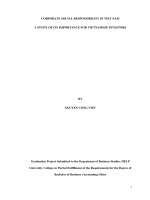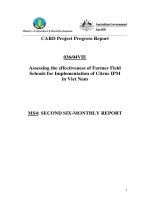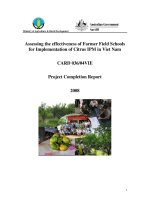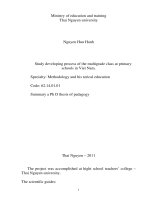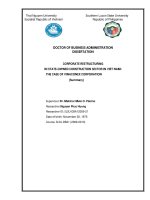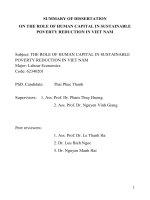Antecedents of the adoption of social network sites the case of facebook in viet nam
Bạn đang xem bản rút gọn của tài liệu. Xem và tải ngay bản đầy đủ của tài liệu tại đây (1.5 MB, 78 trang )
UNIVERSITY OF ECONOMICS IN HO CHI MINH CITY
International School of Business
TRUONG THI HOANG NGOC
ANTECEDENTS OF THE ADOPTION OF
SOCIAL NETWORK SITES:
THE CASE OF FACEBOOK IN VIETNAM
MASTER OF BUSINESS (Honours)
Ho Chi Minh City -Year 2014
UNIVERSITY OF ECONOMICS IN HO CHI MINH CITY
International School of Business
TRUONG THI HOANG NGOC
ANTECEDENTS OF THE ADOPTION OF
SOCIAL NETWORK SITES:
THE CASE OF FACEBOOK IN VIETNAM
ID: 22120133
MASTER OF BUSINESS (Honours)
SUPERVISOR: ASSOC. PROF. LE NGUYEN HAU
Ho Chi Minh City -Year 2014
ACKNOWLEDGEMENT
At the first of my thesis, I would like to thank all those people who made this thesis
possible and an unforgettable experience for my studying.
Foremost, I would like to express my deep appreciation to my supervisor, Assoc. Prof. Le
Nguyen Hau who instructed and helped me enthusiastically during period of the thesis.
Besides my supervisor, I am grateful to the supervisory board for providing me with their
available advices and patient when I need.
I would like to express my gratitude to all ISB staffs that supported necessary materials
and helped summit my papers.
Last but not the least; I would like give my special thanks my family for supporting me
spiritually throughout my life.
Ho Chi Minh City, December, 8, 2014
TRUONG THI HOANG NGOC
ANTECEDENTS OF THE ADOPTION OF SOCIAL NETWORK SITES i
ABSTRACT
The rise of social networking sites in recent rise has aroused the discussion among
the society. Social networking sites not only enable people to connect with friends, but
also can conduct various studies. For example, people can create events; people are able
to open up new relationships on the internet. This study discusses antecedents of the
adoption of social network sites the case of Facebook in Vietnam. Facebook is chosen for
this study as it is the most popular online social networking sites. A survey involving 279
respondents is conducted. The research finds out the three variables (initiating and
maintaining relationships, privacy, and entertainment) had a positive influence to the
intention to adopt Facebook of university students in Ho Chi Minh City, which
completely matched with the discovery discussed in literature. The strongest positive
relationship factor is entertainment to adopt Facebook. It is also found that the effective
difference antecedent factors on the adoption of Facebook when the sample was related
into two sub-groups based on the level of respondent’s extraversion.
Key words: adoption, social networking sites, Facebook, relationships, privacy,
entertainment, extraversion.
ANTECEDENTS OF THE ADOPTION OF SOCIAL NETWORK SITES ii
TABLE OF CONTENTS
ABSTRACT i
LIST OF TABLES v
LIST OF FIGURES v
ABBREVATIONS v
CHAPTER 1. INTRODUCTION 1
1.1. BACKGROUND 1
1.2. RESEARCH PROBLEMS 2
1.3. RESEARCH PURPOSE 3
1.4. SCOPE OF THE RESEARCH 4
1.5. RESEARCH STRUCTURE 4
1.6. SUMMARY 5
CHAPTER 2. LITERATURE
REVIEW AND HYPOTHESES 6
2.1. TECHNOLOGY ACCEPTANCE MODEL (TAM) 6
2. 2. INTENTION TO ADOPT 7
2.3. INITIATING AND MAINTAINING RELATIONSHIP 8
2.4. PRIVACY 9
2.5. ENTERTAINMENT 11
2.6 MODERATING VARIABLE 12
2.7. RESEARCH FRAMEWORK 13
2.8 SUMMARY 14
CHAPTER 3. RESEARCH METHODS
16
3.1. RESEARCH PROCESS
16
3.2. QUESTIONNAIRE 17
3.2.1. Measurement scales 17
3.2.2. Draft questionnaire 20
3.3. PILOT STUDY 20
ANTECEDENTS OF THE ADOPTION OF SOCIAL NETWORK SITES iii
3.4. SAMPLE AND DATA COLLECTION 21
3.4.1. Sampling 21
3.4.2. Data collection 22
3.5. DATA ANALYSIS METHODS 22
3.5.1. Reliability analysis
22
3.5.2. Exploratory factor analysis (EFA) 23
3.5.3. Multiple regression analysis 23
3.6. SUMMARY 24
CHAPTER 4. DATA ANALYSIS AND RESULTS ………………………… 25
4.1. DESCRIPTIVE ANALYSIS
25
4.2. MEASUREMENT OF MEASUREMENT SCALES 26
4.2.1. Reliability analysis 26
4.2.2. Exploratory factor analysis (EFA) 29
4.2.2.1. EFA for independent variables 29
4.2.2.2. EFA for dependent variables
31
4.2.2.3. EFA for moderating variables
31
4.2.3. Pearson correlation coefficient 33
4.3. HYPOTHESES TESTING USING MULTIPLE REGRESSIONS 35
4.3.1. Checking assumption of Multiple Regression 35
4.3.1.1. Sample size
35
4.3.1.2. Assessment multicollinearity of independent variables 35
4.3.1.3. Normality, linearity, homoscedasticity and outliers 35
4.3.2. Evaluating the model
35
4.3.3. Evaluating the independent of variables and checking hypotheses of model 37
4.3.4. Test the effect of moderating variables 38
4.4. SUMMARY 41
CHAPTER 5. CONCLUSIONS AND IMPLICATIONS 42
ANTECEDENTS OF THE ADOPTION OF SOCIAL NETWORK SITES iv
5.1. RESEARCH OVERVIEW 42
5.2. RESEARCH FINDINGS 42
5.3. MANAGERIAL IMPLICATIONS 44
5.4. RESEARCH LIMITATIONS AND DIRECTIONS FOR FUTURE RESEARCH 45
REFERENCES 46
QUESTIONNAIRE 53
BẢNG CÂU HỎI 56
APPENDICES 59
APPENNDIX 1: DESCRIPTIVESTATISTICS 59
APPENNDIX 2: CRONBACH’S APLPHA WITH FULL FOR EACH
CONSTRUCTS 62
APPENNDIX 3: THE FIRST TIME RUNNING FACTOR ANALYSIS
EIGENVALUES (FOR INDEPENDENT VARIABLES) 64
APPENNDIX 4: THE SECOND TIME RUNNING FACTOR ANALYSIS
EIGENVALUES (FOR DEPENDENT VARIABLES) 65
APPENNDIX 5: THE THIRD TIME RUNNING FACTOR ANALYSIS –
EIGENVALUES (FOR MODERATING VARIABLES) 66
APPENNDIX 6: HIGHT EXTRAVERSION 67
APPENNDIX 7: LOW EXTRAVERSION 68
ANTECEDENTS OF THE ADOPTION OF SOCIAL NETWORK SITES v
LIST OF TABLES
Table 1: Scales 17
Table 2: Cronbach’s alpha reliability 22
Table 3: Sample Description 25
Table 4: Cronbach’s alpha test results 28
Table 5: Rotated Component Matrix 30
Table 6: Factor loading of intention variable 31
Table 7: Factor loading of moderating variable 32
Table 8: EFA results 33
Table 9: Correlation among variables 34
Table 10: R Square value (R
2
) 36
Table 11: Anova 37
Table 12: Coefficients 37
Table 13: Comparison of coefficients 39
LIST OF FIGURES
Figure 1: The research model and hypotheses 14
Figure 2: Research process 16
Figure 3: Histogram 69
Figure 4: Normal P-P Plot 69
Figure 5: Scatterplot 70
ABBREVATIONS
SNS: Social networking sites.
TAM: Technology Acceptance Model.
FFM: Five- Factor Model.
KMO: Kaiser-Meyor-Olkin.
EFA: Exploratory Factor Analysis.
ANTECEDENTS OF THE ADOPTION OF SOCIAL NETWORK SITES 1
CHAPTER 1: INTRODUCTION
The chapter introduces the research background, present the research problem as
well as the scope of research. Furthermore, the research structure is also outline.
1.1. BACKGROUND
In this new era, social networking sites (SNS) have achieved a dominant
breakthrough. Millions of people are now attached with this and both online and
conventional activities result in the expanded platform that affects conventional way of
thinking. The popularity of social networking is highly demonstrable by the number of
people using those (Cheung, Chiu & Lee, 2010).What motivated people to use social
network has been an interesting not only in business but also in academic field as well.
Bartlett-Bragg (2007) defined social networks sites as a “range of applications that
augments group interactions and shared spaces for collaboration, social connections, and
aggregates information exchanges in a web-based environment” (p.3). While SNS have
integrated a wide range of technical features, they basically consist of a “profile” and a
list of “Friends” who are also users of the system (Boyd & Ellison, 2008). The user has
complete control over the content of his or her profile, and in some SNS, its visibility to
other users as well. Besides the “profile” and “Friends” list, these SNS offer
“commenting” and “private messaging” features, photo-sharing and video-sharing
capabilities too. People are motivated to get involved in social network sites for a number
of reasons. Making new friends, communicating, and connecting to other people are one
of the prime reasons for using social networks (Lenhart & Madden, 2007).
One of the most popular SNS is Facebook (Mazman & Usluel, 2010; Roblyer,
McDaniel, Webb, Herman & Witty, 2010) which is clear leader of the social
networking sector. Facebook is essentially a personalized profile of which users have
complete control over its content. A user’s profile can be viewed by other users in the
same “network” by default, unless the profile owner specifies otherwise. According to
Facebook statistics, its users spend over 700 billion minutes per month on Facebook. The
Facebook phenomenon is happening all over the world.
ANTECEDENTS OF THE ADOPTION OF SOCIAL NETWORK SITES 2
Facebook is appropriate for the current study as it is the most popular online social
networking site among university students. Originally developed by Mark Zuckerberg,
Dustin Moskovitz and Chris Hughes in 2004 at Harvard University in order to provide
Harvard students with a place in which they could keep in contact with their classmates
and could share study-related information, also they can share creations, tell stories, and
interact with others (Roblyer et al., 2010). Facebook also allow individuals to share
thoughts, ideas, pictures and other content with friends and family members, and to
connect with either former or new friends, making the platform very popular with
university students (Ellison, Lampe & Steinfield, 2007; Golder, Wilkinson & Huberman,
2007; Boyd & Ellison, 2008; Raacke & Bonds-Raacke, 2008). In addition, it creates an
online social space where university students can build and maintain social capital with
others (Ellison et al., 2007; Lytras & Garcia, 2008). It is particularly important for
university students to build social capital with the industry (Chakrabarti & Santoro,
2004).
1.2. RESEARCH PROBLEMS
Instead of maintaining a personal account, Facebook helps user, either individual or
organization, to create and present information related to a specific subject such as
brands, celebrity, or sports. The Facebook owner can then upload pictures, videos, or post
messages in it. For people who are interested in the subject of the Facebook, they can
easily subscribe it by clicking the “Like” button and post message in it to communicate
with the business. Once subscribed, the updates of Facebook will be automatically shown
in subscribers’ personal page for them to browse or leave comments. In this manner,
Facebook creates a social space for people to conveniently interact and share information
with each other. Considering the massive users’ base of Facebook and their intensive
usage, major brands, such as Dell, Samsung have created dedicated Facebook page to
increase their presence in the cyber world and expect to build direct relationship with
their customers.
Many previous studies investigated the Internet uses and SNS adoption. Whether
ANTECEDENTS OF THE ADOPTION OF SOCIAL NETWORK SITES 3
there was a systematic difference between people who used SNS and those who did not
use, a study found that using a particular SNS was not randomly distributed among
internet users (Hargittai, 2008). Many studies found that gender played a role in the
internet uses (Hargittai & Shafer, 2006). Factors such as socioeconomic status have also
been shown to predict the types of Internet uses (Madden & Rainie, 2003). Watkins
(2009) also found that ethnicity played a role in SNS adoption. However, to date, little
research in Vietnam has explored what makes an individual engage in Facebook use.
Facebook can be regarded as an information outlet for brands to reach massive potential
customers with relatively low cost. Meanwhile, it could be beneficial to maintain
customers’ loyalty as well as profitability.
Understanding relationship between main factors affecting intention to adopt
Facebook is an important role for social networking sites developers and enterprises to
satisfy customers’ demand and to have available strategies in the social networking sites
field.
1.3.
RESEARCH PURPOSE
Based on the research question, this study aims at identifying the influencing factors
to the intention to adopt Facebook among university students to understand the features
of social networking sites and the reasons which may affect users. The main objective of
this study is to find factors which affect the intention to adopt Facebook; it also serves as
reference to the operators of social networking websites.
Consequently, in the term of the intention to adopt Facebook of users, the research
questions of the research are raised as two following questions:
What are the key factors affecting the intention to adopt Facebook of users in
Vietnam?
How is impact of these factors on intention to adopt Facebook of uses evaluated
in Vietnamese context?.
ANTECEDENTS OF THE ADOPTION OF SOCIAL NETWORK SITES 4
1.4.
SCOPE OF THE RESEARCH
The research is conducted in Ho Chi Minh City with the respondents who are the
university students in Ho Chi Minh City with various careers. The timeframe of research
was carried out on August, 2014.
1.5. RESEARCH STRUCTURE
This thesis organizes in five chapters. The first chapter is the introduction chapter.
Furthermore, this chapter describes the overview of research background, research
problem, research purpose. Hence, the scope of research and structure of research are
also present.
Chapter 2 is all about presenting previous research done on the stream of studies
related to users’ intention to adopt Facebook. The chapter explains the history and
development of Technology Acceptance Model and Theory of Reasoned Action. This
chapter covers literature review of the previous research and shows hypotheses, as well as
the conceptual framework of the research.
Chapter 3 introduces research methodology and use to test the research model in
previous session. It presents the research process, questionnaire, sample and data
collection and data analysis methods. The measurement scales apply for the research
factors will be determined clearly and suitably. This chapter also defines how to collect
data and analyze the data collected to test the research hypotheses proposed in chapter 2.
Chapter 4 translates data collected from survey, analyses data as well as discusses
the result finding in connection with research model. This chapter explains the empirical
part of the study. This part discusses the method for collecting data used to test the
hypothesis, and it analyses the data received, its reliability and multiple regression.
The last chapter, chapter 5 discusses the results and research finding. This chapter
concludes research overview, research findings, managerial implications, research
limitations and directions for future research.
References and appendixes are included in the end of thesis.
ANTECEDENTS OF THE ADOPTION OF SOCIAL NETWORK SITES 5
1.6. SUMMARY
The research begins the introduction by discussing the research background and the
problem statement is defined to take a closer look at using Facebook in Viet Nam. In
order to narrow down the topic area, the scope of research examined the using Facebook
of university students in Ho Chi Minh City.
The most important thing to remember is that social network sites (Facebook)
provides vast amount of opportunities to user and companies wishing to use SNS to
promote their goods and services. This is a fact acknowledged all over the world, and not
the least in university in Ho Chi Minh City where SNS (Facebook) in general are very
popular. It may seem that there is nothing to study in Ho Chi Minh City related to user
acceptance of SNS (Facebook), due to the fact it is very useful for everybody. All the
more reason, it is interesting and important to distinguish what are the factors that affect
user’s intention to adopt SNS (Facebook).
ANTECEDENTS OF THE ADOPTION OF SOCIAL NETWORK SITES 6
CHAPTER 2: LITERATURE REVIEW AND HYPOTHESES
This section is an overview of literature Facebook’s antecedents which have been
conducted by previous researchers. This research presents popular model which is
Technology Acceptance Model (TAM). Based on these studies, the purposed research
model for the intention to adopt Facebook was presented.
2.1. TECHNOLOGY ACCEPTANCE MODEL (TAM)
Technology Acceptance Model (TAM), was coined by Davis (1989), it successfully
explains or predicts an individual’s acceptance of information technologies, such as e-
mail, voice mail, software packages, or Web surfing (Venkatesh & Davis, 2000). A
purpose of TAM is to provide the impact of external variables on internal variables such
as attitude, intention, and etc. (Kwon & Wen, 2010). TAM received wide attention from
information systems researchers for at least three reasons. First, it has a strong foundation
in psychological theory. Second, it is parsimonious and can be used as a guideline to
develop a successful information system (Venkatesh & Davis, 2000). Third, past stream
of research supports the robustness of the model across time, setting, populations, and
technologies (Venkatesh & Davis, 2000). TAM is based on Theory of Reasoned Action
(TRA). TRA that has its roots in social psychology and tries to explain why people
engage in consciously intended behaviors. TRA provides that intention determines
person’s behavior, and both attitude and subjective norm influence person’s intention
(Fishbein & Ajzen, 1975). Davis introduced it into information systems and elaborating
on the Theory of Reasoned Action, suggests a model that predicts intention to use a new
technology. This theory has been useful to explain the user’s acceptance of information
systems. Now, the TAM has been through in different situations, different sample of
extensive testing, and proven in the interpretation of information system using has good
reliability and validity. Therefore they use TAM as a base model and extended the model
by adding additional variables to the model depending on the types of technologies they
studied. For example, Kamarulzaman (2007) on his study of internet shopping adoption
drew upon TAM and included personal and cognitive influence. Thongmark (2013) also
ANTECEDENTS OF THE ADOPTION OF SOCIAL NETWORK SITES 7
modified the original TAM by including Instructor Characteristics; Student
Characteristics were added to his of Social Network System in Classroom:
Antecedents of Edmodo © Adoption.
Based on existing studies, this research also use TAM as the base model and extend
the model by including other variables which this study believe are important for the
studies of Facebook adoption in Vietnam.
2.2. INTENTION TO ADOPT
The behavioral intention measure was designed to tap intentions to use new media
production tools for professional purposes. Understanding the behavior of individuals has
always been a concern for social psychology researchers. Most studies concerned with
the prediction of behavior from attitudinal variables are conducted in the framework of
the theory of planned behavior (TPB) (Ajzen 1991) and, to a lesser extent, its
predecessor, the theory of reasoned action (TRA). TPB is a general model that has been
applied in many diverse domains. The model posits that behavioral intention is a function
of, in addition to attitude, subjective norm, referred to the individual’s perceptions of
general social pressure to perform a given behavior (Ajzen, 1991), and perceived
behavioral control, defined as the perception of internal and external resource constraints
on performing the behavior (Ajzen, 1991).
In1986,which Davis in his doctoral thesis presented in the "technology acceptance
model" has been widely studied and applied, this model since it was proposed by the
research scholars constantly verification and perfect. These theoretical basic orientation
and research are follow" attitude behavior" paradigm, namely the actual action is
decision by behavioral intention, behavior intention influence by attitudes, and attitudes
final influence by belief.
Use intention reflects the will when the user to register with SNS demonstrated; it is
the necessary condition before the user actual use. In the past studies, scholars have
ANTECEDENTS OF THE ADOPTION OF SOCIAL NETWORK SITES 8
proved use intention is a reliable observation variable, between user intention and actual
behavior exists direct correlation; use intention can well predict user behavior.
2.3. INITIATING AND MAINTAINING RELATIONSHIPS
Most research to date has focused on the use of Facebook to initiate and maintain
relationships. In past social sciences research, analysis showed that the relations between
friends shall mutually affect their behavior and thinking, resulting into many similarities
(Van Duijn, Zeggelink, Huisman, Stokman & Wasseur, 2003). SNS (e.g. Facebook)
strengthen existing connections and communities by keeping its users regularly updated
about activities and affairs of their contacts. The application programs used in Facebook
are not innovative technologies but rather emphasizes on the concepts of “simple to use”,
“connecting” and “share”; the games and updates enable people to interact with friends,
which increase discussion topics and bring people closer (Shin, 2010). Research has
shown that Facebook is employed mostly to keep in touch with people and to know them
better (Golder et al., 2007). Some research has looked at how Facebook facilitates in
developing online relationship among its users. Facebook assists its users to
communicate with their family members, friends, professional contacts. It also aids them
in connecting and interacting with new contacts (strangers) who share similar interests.
Facebook promotes relationship building between its users by enabling users to track
others in their communities and Facebook facilitates people to maintain relationships
with existing offline contacts and helps them to develop new relationships (Ellison et al.,
2007). Raacke and Bonds-Raacke (2008) found that the vast majority of college students
use Facebook for making new friends and locating old acquaintances. Stern and Taylor
(2007) found that only a small number of users try to meet new people or try to initiate a
relationship via Facebook and that most of them use it to maintain already existing
relationships.
People are increasingly using Facebook for communication, social network and
interaction. Using Facebook becomes part of a routine. Facebook was also found to be
frequently used to maintain distant relationships, as it allows for immediate
ANTECEDENTS OF THE ADOPTION OF SOCIAL NETWORK SITES 9
communication between users who are geographically far (Golder et al., 2007). Bryant
and Marmo (2009) observed the types of relationships that a sample of college students
had with their Facebook friends, their behaviors adopted for relational maintenance, and
how these strategies changed according to the type of relationship. They found that
relationship maintenance on Facebook usually occurs for casual relationships or
acquaintances and that close friends and couples tend to use other media to maintain their
relationships. Therefore, the first hypothesis is proposed as follows:
H1: There is a positive impact of initiating and maintaining relationships on the
intention to adopt Facebook.
2.4. PRIVACY
Social networking sites have changed the levels of privacy among friends and
acquaintances. Further, the growth of social networking sites has increased the need for
concern about information privacy. Specifically, information privacy is defined as the
interest individuals have in controlling, or at least significantly influencing, the handling
of data about themselves (Clarke, 1988). Sheehan and Hoy (1999) found that as
individuals’ concerns about privacy increase, the frequency with which they register for a
web site decreases. Privacy and security are critical for gaining customer’s confidence in
a website (Belanger, Hiller & Smith, 2002). The same should also in different social
networking sites.
Social interaction in real life brings many different relations among people,
however social networking sites, reduce relationships to simply being friends or not
(Gross & Acquisti, 2005). Many people on social networking sites are willing to connect
with anyone on the site, while others are more conservative. Since users can only
categorize others as friends or not, some are more likely to accept people that they barely
know or trust. Consequently, social networking sites present interesting privacy concerns
for users. The risk for the unsuspecting or unaware user becomes great and the need for
privacy protection for users becomes significant.
ANTECEDENTS OF THE ADOPTION OF SOCIAL NETWORK SITES 10
Bart, Shankar, Sultan and Urban (2005) empirically discovered that privacy is an
important driver of trust, particularly for community Web sites compared with other sites
because sharing information among members on community Web sites is prevalent, this
results in users’ susceptibility of risking private information. Research studies have found
that the users of social networking sites wish their personal contact information such as
their email, phone, and instant messenger screen name to remain private (Dwyer, Hiltz &
Passerini, 2007). Acknowledging this right to privacy and safety, most social networking
sites have made it possible for users to keep this information secret. Still, these privacy
concerns bring about the need for protection from the social networking sites themselves.
When considering inherent characteristics of SNS, privacy presumably a critical
issues to those who use them. Personal information can be displayed on Facebook
including name, address, e-mail, phone number, alma mater (high school and college),
current employer and marital status. In addition, questions about spiritual and political
beliefs, interests and hobbies can be shared. With each of these primary areas, users can
determine whether the public, friends-of-friends, or friends only can see the information.
There are many different aspects the users of social networking sites will need to
consider with regards to their need for privacy. For example, a user might want to keep
their information available to a small circle of friends, but not with the general public.
There are also cases where information can be made public but not to certain friends.
Facebook extremely holds the personal information of its users with great
importance. Through platforms, users can authorize their information and be sent to
various application programs. Facebook designed a series of privacy control options,
allowing users to set who can the messages they posted. People do not have to worry
messages are revealed. This suitable level of information disclosure enables easy
interaction. Van Dyke, Midha and Nemati (2007) recognize high privacy concerns be
true for Facebook. Users need to provide a good amount of personal information for
getting membership can affect trust levels online and in turn constrain an individual's
intention to transact or interact online. Therefore, the second hypothesis is proposed as
follows:
ANTECEDENTS OF THE ADOPTION OF SOCIAL NETWORK SITES 11
H2: There is a positive impact of privacy on the intention to adopt Facebook.
2.5. ENTERTAINMENT
Entertainment is defined as the ability to fulfill an audience needs for aesthetic
enjoyment, fun diversion, or emotional pleasure (Ducoffe, 1996). Entertainment is
derived from fun and relaxation through playing or otherwise interacting with others. It is
defined that the intrinsic reward given by the use of the technology or service. SNS users
perceive Facebook an important source of entertainment. SNS (e.g. Facebook) are
entertaining and exciting. SNS provide a lot of enjoyment to its users and create a sense
of connectedness among users. People use Facebook to entertain themselves or to feel
pleasure. Studies have shown that many participants do so for entertainment through
exploring different fictional identities, encountering, and solving virtual challenges, etc.
Studies have found that user entertainment plays a significant role in the success of
certain technology. Previous research suggested that one primary function of using
Facebook is entertainment (Dogruer, Menevis & Eyyam, 2011). Entertainment was a key
determinant of both consumer usage intention and actual use of websites. Van der
Heijden (2003) introduced the concept of entertainment to explain consumers’ use of
Web sites. This perception is based on the extent to which enticing consumers’
entertainment is perceived through the activity of using a specific product or service,
rather than from any of its own performance consequences. Similar to the definition of
perceived enjoyment, perceived playfulness, entertainment, or fun, was also is also a key
indicator of the intention to use blogs and similar hedonic systems (Van der Heijden,
2003). Study has found perceived enjoyment to be a significant antecedent to users’
intentions to adopt technologies for activities such as web browsing (Novak, Hoffman &
Yung, 2000). Moreover, Moon and Kim (2001) referred to the term entertainment as the
pleasure individuals feel when committing a specific behavior. They found that
entertainment was a dominant factor for user's acceptance of the Internet. Entertainment
is an important factor motivating students to use Facebook (Park, Kee & Valenzuela,
2009). Therefore the third hypothesis is proposed as follows:
ANTECEDENTS OF THE ADOPTION OF SOCIAL NETWORK SITES 12
H3: There is a positive impact of entertainment on the intention to adopt Facebook.
2.6. MODERATING VARIABLE
A great deal of past research has sought to find out the many ways that personality
may affect individuals’ media use patterns, particularly on the Internet or online. This is
because people are different in their social and psychological circumstances, which may
affect how and why they use the differing forms of media to fulfill their personal needs. It
is important to note that the expression of one personality factor may depend on where an
individual stands on another factor, which suggests that personality characteristics
interact to shape ones online behavior. To evaluate this research model, additional
moderating variable is added: extraversion of personal orientation.
As a commonly used approach in research on personality, The Five-Factor Model
(FFM) is the most widely accepted model of personality and has emerged as the unifying
theory for the study of personality. The FFM is based on the theory that an individual’s
personality may be evaluated by determining how they rank on five factors: neuroticism,
extraversion, openness to experience, agreeableness and conscientiousness (McCrae &
John, 1992). The trait of extraversion seems to be of particular interest. Extraversion
represents an individual’s level of sociability and outgoingness. Extraversion is
characterized by a person's tendency to seek stimulation in the external world, to be
outgoing, talkative, friendly, and socially active. Extraverts take an energetic approach
towards the outside world and can be generally described as sociable, active, assertive
and expressing positive emotions. This trait, extraversion, reflects a person’s tendency to
exhibit social behaviour and to experience positive emotions (Ross, Orr, Sisic,
Arseneault, Simmering & Orr, 2009).
Various studies examined the FFM within the environment of social network sites
and found that extraversion is the most dominant characteristic that influences
individuals' participation in social network sites (Danowski & Zywica, 2008; Fornasier,
Wilson & White, 2010). The importance of extraversion as an antecedent when studying
technology and service adoption has only been studied by a few researchers. In recent
ANTECEDENTS OF THE ADOPTION OF SOCIAL NETWORK SITES 13
years, more and more studies have been exploring the relationship between extrovert
types and their behavior on social network sites. First of all, extraversion has a positive
influence on the use of Internet (Kiesler, Kraut, Cummings, Boneva, Helgeson &
Crawford, 2002) and the use of SNS (Ross et al., 2009). Moreover, in their study on
relating personality to the TAM, Devaraj, Easley and Crant (2008) found out that
extraversion had a significant indirect influence on the intention to use. Several studies
found that the factors that impact on the acceptance of using Facebook to different
degrees when the participation of personality (extraversion). For example, Cunningham
(2007) suggested that high extraversion would have different preferences for website design than
low extraversion. Ross et al (2009) found that highly extroverted people joined more virtual
groups than others. In addition. From a general consensus of the authorities in this area, the
Extravert personality factor has the most significant impact on social networking use.
Thus, the extraversion is expected to influent user intention. Therefore the fourth
hypothesis is proposed as follows:
H4: The impacts of the above-mentioned antecedents on intention to use Facebook
are moderated by personal orientation (extraversion).
2.7. RESEARCH FRAMEWORK
A research framework which is proposed to show the relationship between three
independent variables consisting of “initiating and maintaining relationship”, “privacy”
and ”entertainment” and one dependent variable, namely “intention to adopt Facebook” .
It also shows the effecting of personal orientation (extraversion) as moderating variable
on the impacts of the above-mentioned antecedents on intention to use Facebook.
Base on above literature reviews, the relationship between factors affect to the
intention to adopt Facebook is briefly described in the figure 1:
ANTECEDENTS OF THE ADOPTION OF SOCIAL NETWORK SITES 14
H1
H3
H4
Figure 1: The research model and hypotheses
The hypotheses of this research include:
H1: There is a positive impact of initiating and maintaining relationships on the
intention to adopt Facebook.
H2: There is a positive impact of privacy on the intention to adopt Facebook.
H3: There is a positive impact of entertainment on the intention to adopt Facebook.
H4: The impacts of the above-mentioned antecedents on intention to use Facebook
are moderated by personal orientation (extraversion).
2.8. SUMMARY
Technology Acceptance Model, Theory of Reasoned Act and Theory of Planned
Behavior on are chose as a basis for this study. The reason for choosing they are that the
models have been successfully used in several previous researches related to information
systems. Additionally, similar determinants can be acknowledged to influence the user
acceptance and adoption of SNS (Facebook), whether or not these studies have been
using Technology Acceptance Model and Theory of Reasoned Action as the framework.
Privacy
Initiating & maintaining
Relationships
Entertainment
Intention to
Adopt
Moderating Variable:
Personal Orientation
(Extraversion)
H2
ANTECEDENTS OF THE ADOPTION OF SOCIAL NETWORK SITES 15
The following three factors have been identified as common determinants of
predicting the intention to use Facebook. Therefore, the researcher selected for closer
investigation in this research: Initiating and maintaining relationship, Privacy and
Entertainment. Moreover, the effects of the above-mentioned antecedent factors on the
adoption of Facebook are moderated by the level of user’s extraversion.
The reviewed literature works as a good basis in developing a research model to
measure the factors that influence users’ intention to adopt Facebook and their decision
on whether or not to adopt Facebook.
ANTECEDENTS OF THE ADOPTION OF SOCIAL NETWORK SITES 16
CHAPTER 3: RESEARCH METHODS
This chapter includes five parts: the first part is research process in which is the way
to conduct research is presented; the second part is research sampling; the third part is
measurement scales and the last part introduces the methods to analyze data.
3.1. RESEARCH PROCESS
This study used two research methods. The first phase, qualitative research
identified the models, factors, suitable measurement variables for research in HCMC.
Through the previous relevant researches, the questionnaire was built then running the
pilot test for checking the efficiency and the meaning of the questions. The pilot test was
purposed to explore and define the relevant items and building a completed
questionnaire. The second phase, quantitative survey was the main approach of this
study. The goal is to identify the factors affecting the intention to adopt Facebook.
Research process includes the steps as illustrated in Figure 2:
Figure 2: Research process
Problem
definition
Literature
review
Measurement
scales
Research model
The draft of
questionnaire
Pilot test
The final
questionnaire
Quantitative
research
Assessment of
measurement
(Cronbach alpha, EFA)
Testing of hypotheses
(Standard multiple regression)
ANTECEDENTS OF THE ADOPTION OF SOCIAL NETWORK SITES 17
3.2. QUESTIONNAIRE
3.2.1. Measurement scales
Using well-known and validated scales, there are advantages to examine
individual’s behavior on adoption of Facebook. For better validation, the items have
already developed (Table 1). To measure Initiating and Maintaining Relationships, 3
items of initiating and maintaining relationships were adapted from Dholakia, Bagozzi
and Pearo (2004) and Neelotpaul (2013). In the case of Privacy, the items were suggested
by Neelotpaul (2013), Ariyachandra and Bertaux (2009). The items for Entertainment
were adaption of Dholakia et al. (2004), Ariyachandra and Bertaux (2009). The items for
intention to adopt Facebook were adaption of Ariyachandra and Bertaux (2009). To
determine the degree of extraversion, the Extraversion subscale of the Dutch NEO Five-
Factor Inventory (Hoekstra, Ormel & De Fruyt, 2003; Bouwman, 2011) was used,
participants were asked to rate their agreement on the 12-items of the Extraversion
subscale. A higher score on this scale indicates a higher level of extraversion as a
personality trait. For the items, there are some modifications and wording revisions to fit
this study. Additional items were included for capturing demographic information such
as gender of the students All scales were in 5 -points Likert type (1 = “strongly
disagree, 5 = “strongly agree).
Table 1: Scales
Construct
Coding
of
variables
Original Items
Adjusted Items
Initiating&
Maintaining
Relationships
(Neelotpaul,
2013; Dholakia et
al. , 2004)
IMR01
Able to connect and
socialize with new
persons through Facebook
Using Facebook enables
me to connect and
socialize with new
persons
IMR02
To stay in touch
Using Facebook enables
me to stay in touch with
friends

